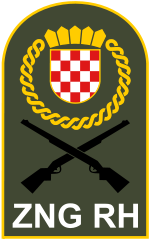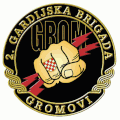National Guard (Croatia)
|
Corps of the National Guard of |
|
|---|---|
 National emblem (sleeve badge , left) |
|
| active | April 18, 1991 to November 3, 1991 |
| Country |
|
| Type | National Guard |
| Strength | July 1991: 10,000 |
| Insinuation |
|
| march | Mi smo garda Hrvatska (We are Croatia's Guard) |
| Anniversaries | May 28 ( Armed Forces Day ) |
| Butcher | Croatian war |
| commander | |
| Important commanders |
|
The Corps of the National Guard of the Republic of Croatia ( Croatian Zbor narodne garde Republike Hrvatske , ZNG RH for short) was founded on April 18, 1991 and was initially subordinate to the Interior Ministry. The National Guard of Croatia comprised four active brigades with around 10,000 fighters until the end of July 1991 and received another four reserve brigades in the same summer.
In the initial phase of the Croatian War, the National Guard proved its worth especially in the siege of Dubrovnik , the Battle of Vukovar and the Battle of Osijek in the fight against the Yugoslav People's Army and Serbian irregulars .
On November 3, 1991, the last units of the National Guard were absorbed into the newly formed Croatian armed forces .
history
Preconditions

Until spring 1991, the Croatian police were the only armed force in an escalating series of armed clashes with separatist Krajina Serbs , ranging from the tree trunk revolution to the proclamation of the " Serbian Autonomous Province of Knin-Krajina " to the armed incident near the Plitvice Lakes . As a first step towards its own Croatian army, the Croatian State Council under President Franjo Tuđman therefore decided on April 10, 1991 to convert the special forces of the Croatian police into a national guard. On April 18, 1991, the Croatian Parliament approved the law on the formation of a national guard with the tasks of defending the borders of the republic and territorial integrity, as well as combating terrorism . The National Guard was to be made up of around 1,000 police officers and 9,000 male and female volunteers . The last Yugoslav President and later Croatian President Stjepan Mesić commented on the creation of the National Guard:
“In the end, Europe saw that Milošević didn't want an agreement, but it was already too late. The war had already expanded. The United Nations then announced the arms embargo against Slovenia and Croatia. Serbia had all the weapons of the Yugoslav People's Army . According to the Yugoslav constitution, we had no right to build an army. So we started an evasive maneuver and, within the framework of the Ministry of the Interior, founded the national guard. It's something like the French gendarmerie or the Italian carabinieri , i.e. police officers who are allowed to carry long guns . We were able to do that because of the 1974 constitution . When the resolution was passed that all paramilitary units must be disbanded, it was assumed in Serbia that this also applies to this police unit. But then, as President of Yugoslavia, I explained to them that this is not a paramilitary unit, but the police. This unit later became our army. "
Formation of the Guard Brigades and the Zrinski Battalion

From special units of the police established professionally-active Guard Brigade ( "A" brigade) and a squad of former Foreign Legionnaires formed battalion Zrinski ( Bojna Zrinski ) were the public for the first time at a military parade on May 28, 1991 at Stadium Kranjčevićeva of Zagreb presents. The total strength at that time was around 3,000 to 4,000 men. Within the guard brigades, small units of company or battalion strength were usually formed in order to be able to provide professional support to the police on site and later also to the reserve brigades. In July 1991, each of the four guards brigades comprised about 2,000 men.
Formation of the reserve brigades
In addition to the professional brigades, regional reserve brigades ("R" brigades) were set up from summer 1991.
Armament
In the period from June to September 1991, the Guard Brigades were the only Croatian units that were adequately equipped with small arms. To antitank only were handguns (the "especially crossbow ") are available.
Organization (May to August 1991)

Active Brigades and Independent Battalion (creation date)
- Zrinski Battalion , (May 18, 1991)
- 1st Guard Brigade, (May 25, 1991)
- 2nd Guard Brigade, (May / June 1991)
- 3rd Guard Brigade, (May / June 1991)
- 4th Guard Brigade, (May 28, 1991)
Reserve brigades and independent battalions (date of creation, if applicable)
- 99th Zagreb - Peščenica Brigade
- 100th Zagreb Brigade
- 101st Zagreb- Susedgrad Brigade
- 102nd Novi Zagreb Brigade
- 103rd Krapina Brigade
- 104th Varaždin Brigade
- 105th Bjelovar Brigade
- 106th Osijek Brigade
- 107th Valpovo Brigade
- 108th Slavonski Brod Brigade
- 109th Vinkovci Brigade
- 110th Karlovac Brigade
- 111th Rijeka Brigade
- 112th Zadar Brigade
- 113th Šibenik Brigade
- 114th Split Brigade (June 1, 1991)
- 117th Koprivnica Brigade (late August 1991)
- 118th Gospić Brigade (August 26, 1991)
- 120th Sisak Brigade (August 15, 1991)
- 50th Independent Virovitica Battalion
- 51st Independent Vrbovec Battalion
- 52nd Independent Pula Battalion (not established)
- 53rd Independent Dugo Selo Battalion
- 54th Independent Čakovec Battalion
- 55th Independent Bjelovar Battalion
- 56th Independent Kutina Battalion
- 57th Independent Sisak Battalion (June 15, 1991)
- 61st Independent Jastrebarsko Battalion
- 62nd Independent Novska Battalion
- 63rd Independent Požega Battalion, (June 7, 1991)
- 65th Independent Ivanić-Grad Battalion
- Klek Battalion ( Ogulin ), (July 7, 1991)
- Metković Battalion
- Makarska Battalion
Symbols
march
The song Mi smo garda Hrvatska (We are Croatia's Guard) was composed and written in 1991 by Mladen Kvesić in the style of a marching song . A short interlude features an excerpt from the US Battle Hymn of the Republic . There is another version of the song for marching singing without musical accompaniment. The march is still played by the military orchestra of the Croatian Armed Forces at military parades and ceremonial occasions .
| Croatian text | German translation |
|---|---|
|
|
|
|
|
|
|
|
|
|
banner
Hat badge
Emblems of some of the Guard Brigades
Others
Every year on May 28, Croatia celebrates the anniversary of the first National Guard military parade as Armed Forces Day .
Web links
- Short TV documentary about the formation and first parade of the National Guard in the daily history series TV kalendar of the Croatian television HRT (May 28, 2013) on YouTube
- Mladen Kvesić: Mi smo garda Hrvatska (1991); with recordings of the first military parade and operations by the National Guard on YouTube
source
- Central Intelligence Agency [CIA] - Office of Russian and European Analysis (ed.): Balkan Battlegrounds: A Military History of the Yugoslav Conflict . tape 2 . Washington DC 2003, p. 45-48 .
Individual evidence
- ^ Adelheid Wölfl: Ex-President: Stjepan Mesić: The world perceived Yugoslavia incorrectly. derstandard.at, June 25, 2016, accessed on December 15, 2019 (interview).




